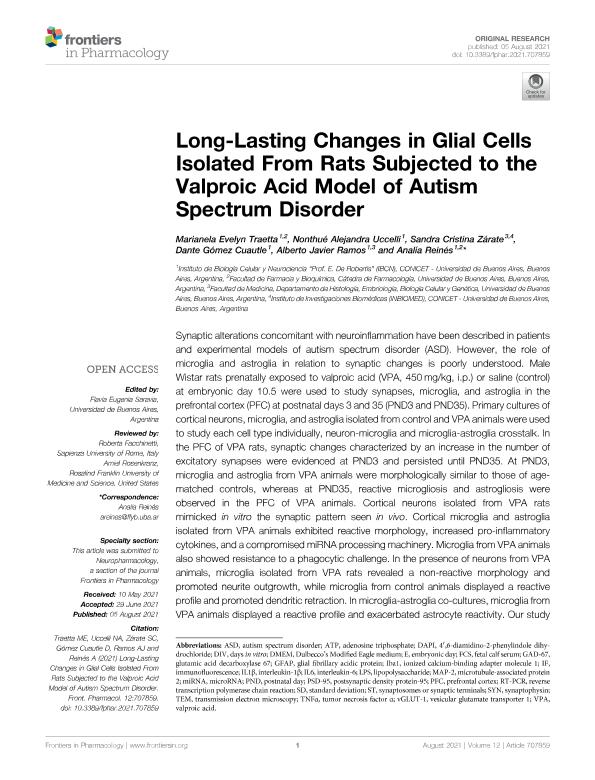Artículo
Long-lasting changes in glial cells isolated from rats subjected to the valproic acid model of autism spectrum disorder.
Traetta, Marianela Evelyn ; Uccelli, Nonthué Alejandra
; Uccelli, Nonthué Alejandra ; Zarate, Sandra Cristina
; Zarate, Sandra Cristina ; Gomez Cuautle, Jose Dante Daniel
; Gomez Cuautle, Jose Dante Daniel ; Ramos, Alberto Javier
; Ramos, Alberto Javier ; Reines, Analia Gabriela
; Reines, Analia Gabriela
 ; Uccelli, Nonthué Alejandra
; Uccelli, Nonthué Alejandra ; Zarate, Sandra Cristina
; Zarate, Sandra Cristina ; Gomez Cuautle, Jose Dante Daniel
; Gomez Cuautle, Jose Dante Daniel ; Ramos, Alberto Javier
; Ramos, Alberto Javier ; Reines, Analia Gabriela
; Reines, Analia Gabriela
Fecha de publicación:
07/2021
Editorial:
Frontiers Media
Revista:
Frontiers in Pharmacology
ISSN:
1663-9812
Idioma:
Inglés
Tipo de recurso:
Artículo publicado
Clasificación temática:
Resumen
Synaptic alterations concomitant with neuroinflammation have been described in patients and experimental models of autism spectrum disorder (ASD). However, the role of microglia and astroglia in relation to synaptic changes is poorly understood. Male Wistar rats prenatally exposed to valproic acid (VPA, 450 mg/kg, i.p.) or saline (control) at embryonic day 10.5 were used to study synapses, microglia, and astroglia in the prefrontal cortex (PFC) at postnatal days 3 and 35 (PND3 and PND35). Primary cultures of cortical neurons, microglia, and astroglia isolated from control and VPA animals were used to study each cell type individually, neuron-microglia and microglia-astroglia crosstalk. In the PFC of VPA rats, synaptic changes characterized by an increase in the number of excitatory synapses were evidenced at PND3 and persisted until PND35. At PND3, microglia and astroglia from VPA animals were morphologically similar to those of age-matched controls, whereas at PND35, reactive microgliosis and astrogliosis were observed in the PFC of VPA animals. Cortical neurons isolated from VPA rats mimicked in vitro the synaptic pattern seen in vivo. Cortical microglia and astroglia isolated from VPA animals exhibited reactive morphology, increased pro-inflammatory cytokines, and a compromised miRNA processing machinery. Microglia from VPA animals also showed resistance to a phagocytic challenge. In the presence of neurons from VPA animals, microglia isolated from VPA rats revealed a non-reactive morphology and promoted neurite outgrowth, while microglia from control animals displayed a reactive profile and promoted dendritic retraction. In microglia-astroglia co-cultures, microglia from VPA animals displayed a reactive profile and exacerbated astrocyte reactivity. Our study indicates that cortical microglia from VPA animals are insensitive or adapted to neuronal cues expressed by neurons from VPA animals. Further, long-term in vivo microgliosis could be the result of altered microglia-astroglia crosstalk in VPA animals. Thus, our study highlights cortical microglia-astroglia communication as a new mechanism implicated in neuroinflammation in ASD; consequently, we propose that this crosstalk is a potential target for interventions in this disorder.
Palabras clave:
ASTROCYTE
,
AUTISM
,
MICROGLIA
,
NEUROINFLAMMATION
,
SYNAPSE
Archivos asociados
Licencia
Identificadores
Colecciones
Articulos(BIOMED)
Articulos de INSTITUTO DE INVESTIGACIONES BIOMEDICAS
Articulos de INSTITUTO DE INVESTIGACIONES BIOMEDICAS
Articulos(IBCN)
Articulos de INST.DE BIOLO.CEL.Y NEURCS."PROF.E.DE ROBERTIS"
Articulos de INST.DE BIOLO.CEL.Y NEURCS."PROF.E.DE ROBERTIS"
Citación
Traetta, Marianela Evelyn; Uccelli, Nonthué Alejandra; Zarate, Sandra Cristina; Gomez Cuautle, Jose Dante Daniel; Ramos, Alberto Javier; et al.; Long-lasting changes in glial cells isolated from rats subjected to the valproic acid model of autism spectrum disorder.; Frontiers Media; Frontiers in Pharmacology; 12; 7-2021; 1-20
Compartir
Altmétricas



